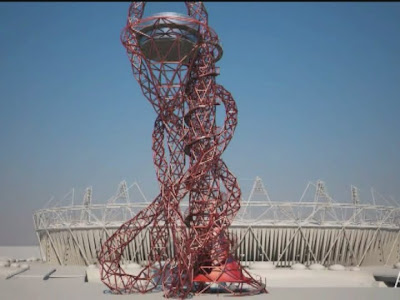 When I was being shown round the 2012 Olympic site last year, the conversation about art projects to coincide referenced mysteriously “the Mayor’s commission”, which was separate from all the other cultural projects. This week the mystery was revealed. Anish Kapoor’s ArcelorMittal Orbit Tower. This is yet another dismal example of the big is good school of art. This practice has its roots in public art in regeneration. It is an established reality that art can animate environmental and economic regeneration. But as everyone knows, anyone can do art, so pretty quickly the regeneration industry thought it could achieve the same effect without using artists – and so two things happen, you get terrible art or you get big art – which is also usually pretty bad. Once Newcastle-Gateshead installed Antony Gormley’s leaden “Angel of the North” achieved its iconic marketing function, the flood-gates opened and all round the country high profile regeneration demands big art. Channel 4 even had a reality TV show called Big Art which followed the commissioning of big public art.
When I was being shown round the 2012 Olympic site last year, the conversation about art projects to coincide referenced mysteriously “the Mayor’s commission”, which was separate from all the other cultural projects. This week the mystery was revealed. Anish Kapoor’s ArcelorMittal Orbit Tower. This is yet another dismal example of the big is good school of art. This practice has its roots in public art in regeneration. It is an established reality that art can animate environmental and economic regeneration. But as everyone knows, anyone can do art, so pretty quickly the regeneration industry thought it could achieve the same effect without using artists – and so two things happen, you get terrible art or you get big art – which is also usually pretty bad. Once Newcastle-Gateshead installed Antony Gormley’s leaden “Angel of the North” achieved its iconic marketing function, the flood-gates opened and all round the country high profile regeneration demands big art. Channel 4 even had a reality TV show called Big Art which followed the commissioning of big public art.  Living in Manchester, I have a particular fondness for the idiocy of big art because the “B of the Bang” commission in the city: this “sculpture” was designed by an engineer not an artist, and not a very good one at that because it fell apart and hilariously had to be dismantled. But we still get this monsters trotted out – there are ‘landmark’ gateway works proposed for Wales and Mark Wallinger’s £2million 50 metre high “White Horse” sculpture which will dominate the Kent landscape if it is built (http://news.bbc.co.uk/1/hi/england/kent/7880889.stm ).
Living in Manchester, I have a particular fondness for the idiocy of big art because the “B of the Bang” commission in the city: this “sculpture” was designed by an engineer not an artist, and not a very good one at that because it fell apart and hilariously had to be dismantled. But we still get this monsters trotted out – there are ‘landmark’ gateway works proposed for Wales and Mark Wallinger’s £2million 50 metre high “White Horse” sculpture which will dominate the Kent landscape if it is built (http://news.bbc.co.uk/1/hi/england/kent/7880889.stm ).And of course there is the northern’s own dismal ‘celebration’ of 2012, the Projected Column (A ‘monumental’ spinning column of cloud and light will rise “as far as the eye can see”) for monumental read of course ‘big’. The bigness thing has also been driven by the Turbine Hall commissions at Tate Modern.
The question with bigness is whether the scale actually carries any meaning other than being able to see the thing from a distance. The White Horse works as a white horse in maquette form. No doubt it would look striking dominating the Kent landscape but so would any other randomly blown up animal or object. The banality of this interchangeability locates the gesture as no more than college-level ersatz surrealism.
However, the Orbit Tower is different because it wants to be treated as ‘architecture’ designed by an artist. In architectural terms, under the arabesque the tower looks to be simply a disguised main vertical with a spiral (staircase). It has two clumsy articulations – the junction with the ground and the form of the viewing platform, this latter element looks like it was designed by someone else and for a different place. I am reminded of Buckminster Fuller’s observation of the superificiality of the Bauhaus – the design looked good but underneath it was still the same old plumbing.
No doubt it will become “London’s Eiffel Tower”, the tourists will queue to go up it, the gormless will, as ever, be impressed with bigness.

